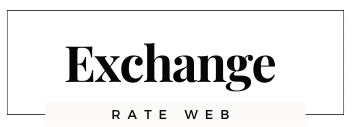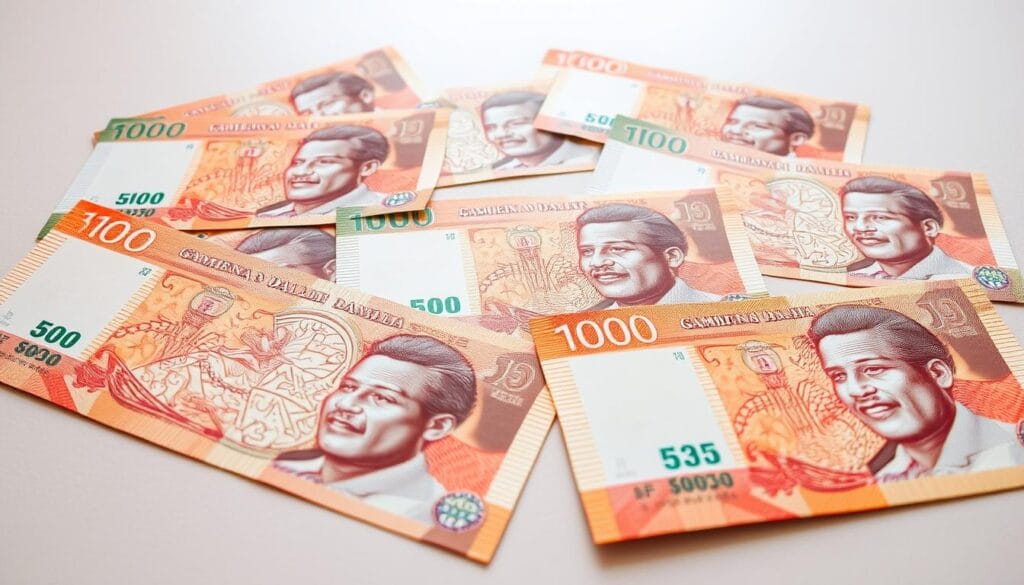
The Gambian dalasi, with the code GMD, has been Gambia’s official currency since 1971. It replaced the Gambian pound. The dalasi was introduced to make money transactions easier in the country. It is issued by the Central Bank of The Gambia.
Switching to the dalasi was a big change for Gambia’s economy. It helped with trade and business. As the national currency, it’s very important for the country’s economy.
Key Takeaways
- The Gambian dalasi is the official currency of Gambia.
- It was introduced in 1971, replacing the Gambian pound.
- The Central Bank of The Gambia is responsible for issuing the dalasi.
- The currency code for the dalasi is GMD.
- The dalasi simplifies monetary transactions within Gambia.
Overview of the Gambian Currency System
The Gambian currency system is centered around the dalasi. It is the official currency of Gambia. It is used for buying and selling goods and services in the country.
The Dalasi as Gambia’s National Currency
The dalasi is split into 100 bututs. This makes the currency system clear. The symbol for the dalasi is ‘D’, used in money transactions.
Key Features of the Dalasi:
- Divided into 100 bututs
- Currency symbol: ‘D’
- Primary medium of exchange in Gambia
The Central Bank of The Gambia’s Authority
The Central Bank of The Gambia is in Banjul. It is in charge of the dalasi. The bank keeps the currency stable and available for use.
The Central Bank’s responsibilities include:
- Issuing currency
- Regulating financial institutions
- Maintaining currency stability
International Recognition of the GMD
The Gambian dalasi (GMD) is known globally. But it’s mostly used in Gambia. It’s traded in foreign markets, with its value set against major currencies.
The GMD’s global standing depends on Gambia’s economy. As Gambia grows, the dalasi will likely play a bigger part in international finance.
Historical Development of the Gambian Dalasi
The Gambian dalasi was introduced in 1971, a key moment in the country’s money history. It marked a big change from the British West African pound. This showed Gambia’s step towards being financially independent.
Transition from Pound to Dalasi in 1971
In 1971, Gambia chose the dalasi as its official money, replacing the British West African pound. This move was key for Gambia’s economic freedom. The dalasi was brought in to make money dealings easier and match the country’s economic needs.
The dalasi was split into 100 bututs, making it easier for people to understand. New banknotes and coins were also introduced. They showed Gambian culture and identity.
Major Currency Reforms Through the Decades
Over the years, the Gambian dalasi has seen big changes. These changes aimed to make the currency safer, update its look, and make it last longer.
- Security Enhancements: New security features were added to stop fake money.
- Design Updates: Banknotes and coins were redesigned to show Gambian heritage and important figures.
- Denomination Changes: New money values were added to help with bigger transactions and make money dealings smoother.
Evolution of Banknote and Coin Designs
The designs of Gambian money have changed a lot since 1971. At first, banknotes showed Gambian leaders and cultural symbols. Later, designs were updated with better security and to honor national events.
Coins have also seen design changes, with new series for important Gambia events. The changes in the dalasi’s money show Gambia’s economic growth and its cultural preservation efforts.
The Gambian dalasi has played a crucial role in the country’s economy. Its evolution shows Gambia’s path to financial independence and its dedication to its culture.
Current Denominations of the Gambian Currency
The Gambian dalasi comes in different sizes to meet various needs. The Central Bank of The Gambia manages and issues this currency.
Banknotes in Circulation
The dalasi banknotes are available in several sizes for different uses. Here are the current banknotes:
- 5 Dalasi: The smallest, for small buys.
- 10 Dalasi: Good for everyday shopping.
- 20 Dalasi: For bigger deals.
- 50 Dalasi: For big purchases.
- 100 Dalasi: For significant transactions.
- 200 Dalasi: The biggest, for large or savings needs.
Coins and Their Values
The Gambian currency also has coins in different values. Here are the coins you can find:
- 1 Butut: The smallest, but less used due to inflation.
- 5 Bututs: Still used in some deals.
- 10 Bututs: A small value coin.
- 25 Bututs: For small buys.
- 50 Bututs: Commonly used.
- 1 Dalasi: Worth 100 Bututs, for various transactions.
Security Features and Anti-Counterfeiting Measures
The Central Bank of The Gambia has added security to the dalasi. These include:
- Watermarks: Visible when light is shone through.
- Holograms: An extra security layer.
- Security Threads: In the paper to stop counterfeits.
- Unique Serial Numbers: Each note has a unique number.
These features ensure the dalasi is real, protecting everyone from fake money.
Latest Exchange Rates of the Gambian Dalasi
Knowing the current exchange rates of the Gambian dalasi is key for travelers and investors. The dalasi is Gambia’s official currency and plays a big role in the economy. Its value against major currencies affects financial transactions.
Current GMD to USD Exchange Rate Analysis
The exchange rate between the Gambian dalasi (GMD) and the United States dollar (USD) is very important. Right now, 1 GMD is worth about 0.019 USD. This rate can change due to many factors like the economy, tourism, and foreign investment.
Using a reliable currency converter is crucial for accurate and up-to-date rates. Tools like Xe Currency Converter offer real-time data. This helps individuals and businesses make better decisions.
Dalasi Performance Against EUR, GBP, and Other Major Currencies
The Gambian dalasi’s value against the Euro (EUR) and British Pound (GBP) is also interesting. Its value against these currencies changes based on global and regional economic trends.
| Currency | Exchange Rate (1 GMD) |
|---|---|
| USD | 0.019 |
| EUR | 0.017 |
| GBP | 0.014 |
Weekly and Monthly Rate Fluctuations
Exchange rates for the Gambian dalasi can change weekly and monthly. This is due to economic indicators and market conditions. It’s important to watch these changes for anyone involved in foreign exchange.
Staying informed about the latest exchange rates and economic news is crucial. Using foreign exchange services with competitive rates and lower fees can also save money on transactions.
Economic Factors Affecting the Gambian Currency Value
Many economic factors shape the dalasi’s value. The Gambian economy, like others, faces ups and downs. These changes can make the dalasi stronger or weaker.
Impact of Tourism Industry on Currency Stability
The tourism industry is big for Gambia’s economy. Its success affects the dalasi’s stability. When tourism grows, more people want the local currency, making it stronger.
But, if tourism falls, the dalasi might get weaker. This is because fewer people want to buy it.
Tourism revenue is key for a stable exchange rate in Gambia. Tourists’ money helps keep the dalasi’s value up. It adds foreign currency to the economy.
Agricultural Exports and Currency Strength
Agricultural exports are important for Gambia’s economy. They help the dalasi stay strong. Products like groundnuts are big exports.
High demand for these products can make the dalasi stronger. Efficient agricultural practices and good global markets help too.
Foreign Investment Influence on the Dalasi
Foreign investment is crucial for the dalasi’s value. Money coming in from abroad can make the dalasi stronger. It goes into sectors like infrastructure and tourism.
More foreign investment means more people want the dalasi. This can make it more valuable. It also helps the economy grow, making the currency more stable.
Foreign Exchange Services in The Gambia
In The Gambia, you can find foreign exchange services through banks and digital platforms. This makes it easy for both locals and tourists to get good deals on currency exchange.
Official Banks and Licensed Exchange Bureaus
The Gambia’s banking system is strong, with many official banks offering foreign exchange. These banks follow rules set by the Central Bank of The Gambia, making transactions safe and fair. You’ll also find licensed exchange bureaus in tourist spots, making it easy to exchange money.
Key features of official banks and licensed exchange bureaus include:
- Competitive exchange rates
- Secure transaction environments
- Regulated by the Central Bank of The Gambia
Digital Payment and Currency Exchange Platforms
Digital payment and currency exchange platforms are becoming more popular in The Gambia. They let you exchange money online or through apps, often with better rates and lower fees than banks.
Some benefits of digital platforms are:
- Convenience of exchanging currency anytime, anywhere
- Often more competitive rates than traditional banks
- Lower transaction fees
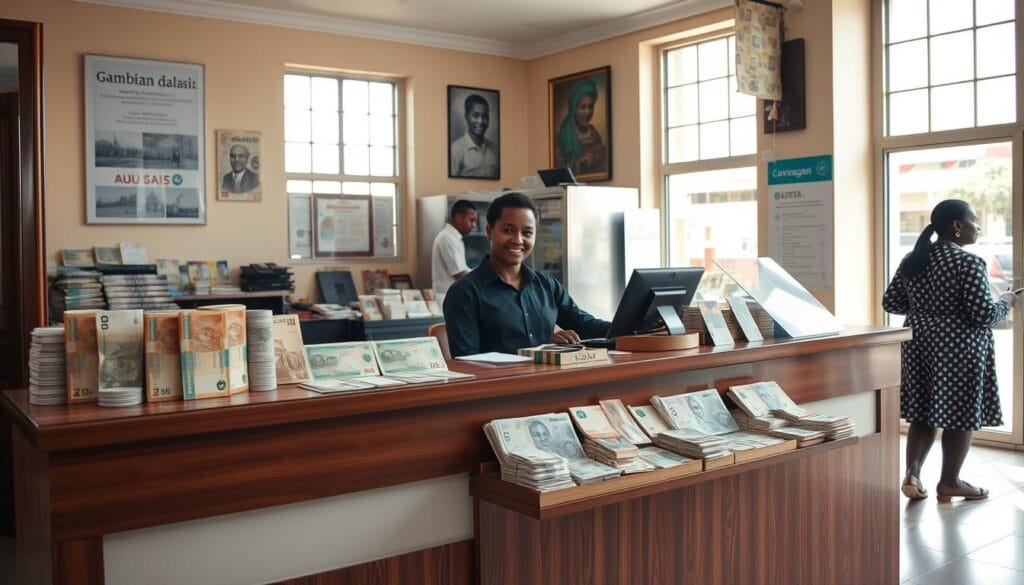
Comparison of Exchange Rates Across Different Services
It’s important to compare exchange rates to find the best deal. Rates can vary between official banks, licensed exchange bureaus, and digital platforms, depending on the currency and amount.
For example, a comparison of USD, EUR, and GBP in The Gambia might show:
- Digital platforms have the best rates for big transactions
- Licensed exchange bureaus might offer better rates for rare currencies
- Official banks provide stability and security, but with slightly less competitive rates
Knowing the strengths and weaknesses of each service helps you choose the best place to exchange your money.
Practical Guide for U.S. Travelers Using Gambian Currency
U.S. travelers going to Gambia need a good guide for the local money, the Gambian Dalasi. Knowing about the Gambian Dalasi and how to use it is key for a smooth trip.
Best Practices for Currency Exchange
U.S. travelers should choose authorized dealers or banks for exchanging money to avoid scams. The Central Bank of The Gambia manages the Gambian money. It’s smart to exchange a little money when you arrive for immediate needs.
Looking at different exchange rates can help you get a better deal. Some hotels and places for tourists might exchange money, but their rates might not be as good.
Cash vs. Card Usage in Different Regions of Gambia
In tourist spots, major credit cards are usually accepted. But, in rural areas, cash in Gambia is a must. Local markets and small shops usually only take cash.
Using ATMs is easy, but watch out for fees and daily limits. Telling your bank you’re traveling can prevent card problems.
Common Currency-Related Challenges and Solutions
One big problem is fake money. Always get money from trusted places and check the bills well.
Another issue is that big banknotes aren’t always accepted in small towns. It’s helpful to break big bills into smaller ones.
By understanding these currency in Gambia points, U.S. travelers can handle their money better during their trip.
Breaking News: Recent Developments in Gambia’s Monetary Policy
The Central Bank of The Gambia has made big changes in its monetary policy. These changes aim to make the Gambian Dalasi (GMD) more stable.
These moves are part of a bigger plan to make the economy stronger. They also aim to improve how the Dalasi does against other major currencies.
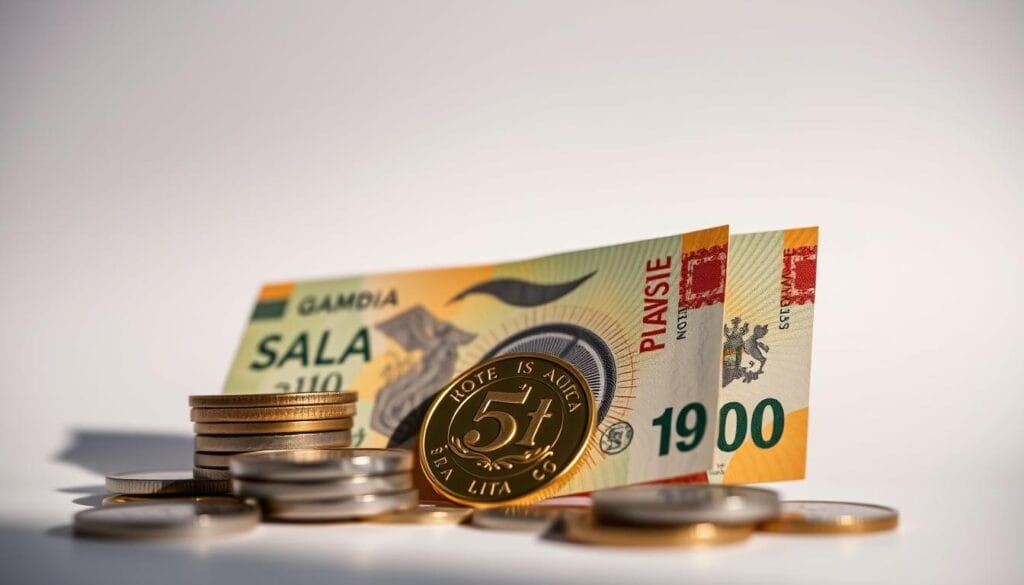
Central Bank’s Latest Interventions in the Currency Market
The Central Bank is working hard to control inflation and keep things stable. They’re doing this by adjusting interest rates and managing foreign exchange reserves.
This helps support the value of the Dalasi. The Bank wants to make the economy more attractive for foreign investment and boost trade.
New Regulations Affecting Currency Exchange
New rules have been put in place to make currency exchange clearer and more efficient. These rules apply to both official banks and licensed exchange bureaus.
The goal is to close the gap between official and unofficial exchange rates. This makes the currency market more reliable for everyone using the Gambia currency.
Impact of Regional Economic Agreements on the Dalasi
Regional economic agreements are key in shaping the Dalasi’s value. Gambia’s involvement in these agreements has strengthened its economic ties with neighbors.
These agreements can lead to more trade and investment. This is good for the currency of Gambia.
As Gambia deals with the global economy’s challenges, keeping its currency stable is a major focus.
Conclusion
The Gambian currency, known as the Dalasi (GMD), is key to the country’s economy. The Central Bank of The Gambia manages it, keeping it stable and trustworthy.
The GMD symbol is a big deal for the Gambian currency. Knowing its value is important for people and businesses in the country. The Dalasi has changed a lot since it started, with new features to fight fake money.
The value of the Gambian currency changes due to things like tourism and farming exports. Foreign investment also plays a role. As the economy grows, the Dalasi’s value will likely change too.
In short, the Gambian currency is very important for the country’s economy. Knowing its history, current state, and future is key for anyone interested in The Gambia. The GMD symbol is a big part of the country’s financial identity.
FAQ
What is the national currency of Gambia?
The national currency of Gambia is the Gambian dalasi, with the currency code GMD.
Who is responsible for issuing the Gambian dalasi?
The Central Bank of The Gambia is responsible for issuing the Gambian dalasi.
What is the symbol for the Gambian dalasi?
The symbol for the Gambian dalasi is not explicitly stated. It is often represented as “D” or “GMD” in financial transactions.
What are the subdivisions of the Gambian dalasi?
The Gambian dalasi is subdivided into 100 bututs.
When was the Gambian dalasi introduced?
The Gambian dalasi was introduced in 1971, replacing the Gambian pound.
What are the current denominations of Gambian dalasi banknotes?
The current denominations of Gambian dalasi banknotes are 5, 10, 20, 50, 100, and 200 dalasi.
What are the values of Gambian dalasi coins?
The values of Gambian dalasi coins are 1, 5, 10, 25, and 50 bututs, and 1 dalasi.
How can I exchange my currency for Gambian dalasi?
You can exchange your currency for Gambian dalasi at official banks, licensed exchange bureaus, or digital platforms.
What are the best practices for currency exchange in Gambia?
It is recommended to exchange currency at official banks or licensed bureaus. Compare rates to get the best deal.
Can I use credit/debit cards in Gambia?
While some businesses accept credit/debit cards, cash is still recommended, especially in rural areas.
What are the common currency-related challenges faced by travelers in Gambia?
Travelers may face challenges like unfavorable exchange rates, counterfeit currency, or limited card acceptance.
How can I avoid counterfeit Gambian dalasi?
To avoid counterfeit Gambian dalasi, exchange currency at official banks or licensed bureaus. Check banknote security features.
What is the current exchange rate of GMD to USD?
The current exchange rate of GMD to USD can be found on reliable websites or at official banks.
How does tourism affect the value of the Gambian dalasi?
Tourism can positively impact the Gambian dalasi’s value. It brings in foreign currency and boosts the economy.
What is the impact of agricultural exports on the Gambian dalasi?
Agricultural exports can positively impact the Gambian dalasi’s value. They earn foreign currency and improve the trade balance.
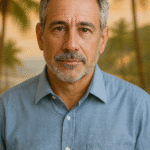
Adam G
This post was created by Adam G, a seasoned financial writer with a passion for explaining currency exchange and market movements
